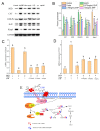Quantitative Structure-Activity Relationship Model to Predict Antioxidant Effects of the Peptide Fraction Extracted from a Co-Culture System of Chlorella pyrenoidosa and Yarrowia lipolytica
- PMID: 31717355
- PMCID: PMC6891513
- DOI: 10.3390/md17110633
Quantitative Structure-Activity Relationship Model to Predict Antioxidant Effects of the Peptide Fraction Extracted from a Co-Culture System of Chlorella pyrenoidosa and Yarrowia lipolytica
Abstract
In this study, the antioxidant components in co-culture of Chlorella pyrenoidosa and Yarrowia lipolytica (3:1 ratio) were confirmed as trypsin-hydrolyzed peptides (EHPs). The EHPs were composed of 836 different peptides with molecular weights ranging from 639 to 3531 Da and were mainly composed of hydrophobic amino acids (48.1%). These peptides showed remarkable protective effects against oxidative stress in HepG2, which may be attributed to their structures. Furthermore, the mRNA and protein levels of nuclear factor erythroid 2-related factor 2 (Nrf2) were significantly lower in the peptide-treated group than in the control group, suggesting that the antioxidant enzyme-coding genes were not activated. The EC50 value of three peptides in the EHPs were in the order of AGYSPIGFVR (0.04 ± 0.002 mg/mL) > VLDELTLAR (0.09 ± 0.001 mg/mL) > LFDPVYLFDQG (0.41 ± 0.03 mg/mL); these results agreed with the prediction of the model (R2 > 0.9, Q2 > 0.5). Thus, EHPs show potential as potent new antioxidant agents.
Keywords: Chlorella pyrenoidosa; HepG2; Yarrowia lipolytica; enzymatic hydrolysis peptides; quantitative structure–activity relationship model.
Conflict of interest statement
The authors declare that they have no conflict of interest.
Figures




References
-
- Cai X., Yang Q., Wang S. Antioxidant and hepatoprotective effects of pigment-protein complex from Chlorella vulgaris on carbon tetrachloride-induced liver damage in vivo. RSC Adv. 2015;116:96097–96104. doi: 10.1039/C5RA17544E. - DOI
-
- Guo Z., Tong Y.W. The interactions between Chlorella vulgaris and algal symbiotic bacteria under photoautotrophic and photoheterotrophic conditions. J. Appl. Phycol. 2014;26:1483–1492. doi: 10.1007/s10811-013-0186-1. - DOI
MeSH terms
Substances
Grants and funding
LinkOut - more resources
Full Text Sources
Medical

